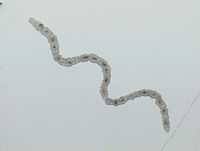Catenulida
| Catenulida | |
|---|---|
 | |
| Catenula lemnae | |
| Scientific classification | |
| Kingdom: | Animalia |
| Phylum: | Platyhelminthes |
| Class: | Turbellaria |
| Order: | Catenulida Meixner, 1924 |
| Families | |
| |
The Catenulida are an order of turbellarian flatworms.
They are relatively small free-living flatworms, inhabiting freshwater and marine environments. The pharynx and intestine are simple in structure, with the latter forming a ciliated sac. They possess two pairs of nerve cords and often a statocyst. The gonads are unpaired. Unusually, the male gonopore opens on the dorsal surface of the animal, above the pharynx, while the female reproductive system lacks any of the usual ducts and related structures found in other turbellarians. Asexual reproduction by paratomy is common, leading to chains of zooids (Latin fem. n. catenula - small chain). Members of the symbiotic genus Paracatenula lack a digestive tract, and instead use intracellular chemoautotrophic bacterial symbionts for their nutrition.[1][2]
References
- Barnes, Robert D. (1982). Invertebrate Zoology. Philadelphia, PA: Holt-Saunders International. p. 229. ISBN 0-03-056747-5.
- "Turbellarian Taxonomic Database". Retrieved 11/03/2010. Check date values in:
|accessdate=(help)
- ↑ Leisch, N; Dirks, U; Gruber-Vodicka, HR; Schmid, M; Sterrer, W; Ott, JA (2011). "Microanatomy of the trophosome region of Paracatenula cf. polyhymnia (Catenulida, Platyhelminthes) and its intracellular symbionts.". Zoomorphology 130 (4): 261–271. doi:10.1007/s00435-011-0135-y. PMID 22131640.
- ↑ Gruber-Vodicka, H. R.; Dirks, U.; Leisch, N.; Baranyi, C.; Stoecker, K.; Bulgheresi, S.; Heindl, N. R.; Horn, M.; Lott, C.; Loy, A.; Wagner, M.; Ott, J. (27 June 2011). "Paracatenula, an ancient symbiosis between thiotrophic Alphaproteobacteria and catenulid flatworms". Proceedings of the National Academy of Sciences 108 (29): 12078–12083. doi:10.1073/pnas.1105347108.